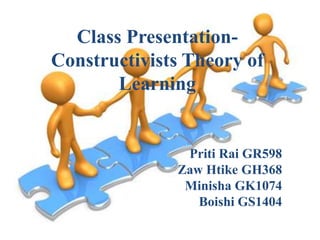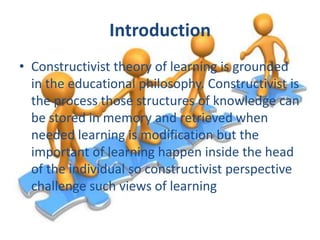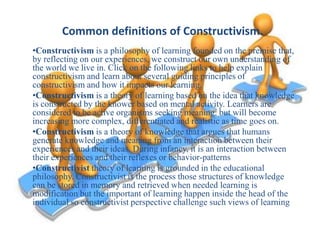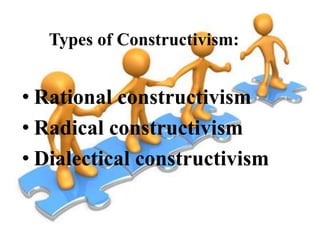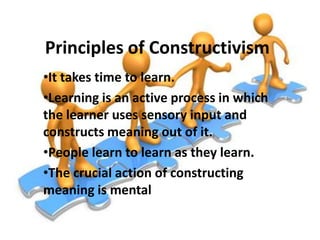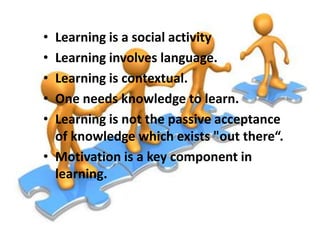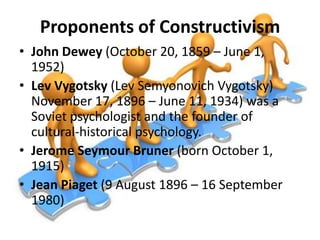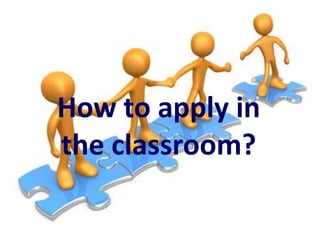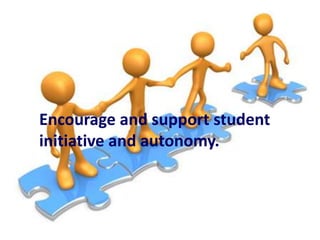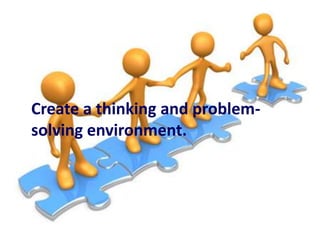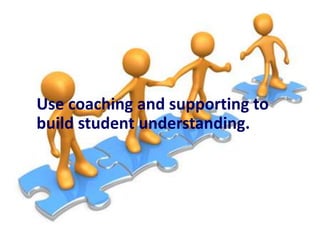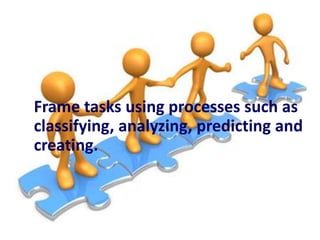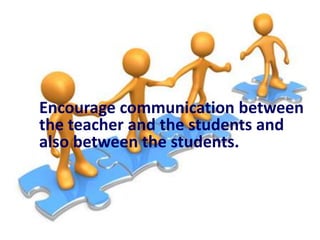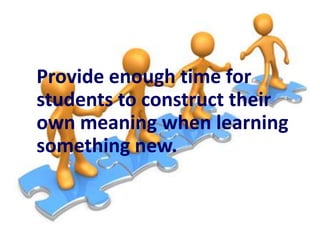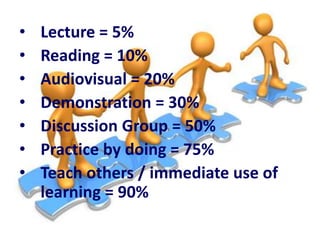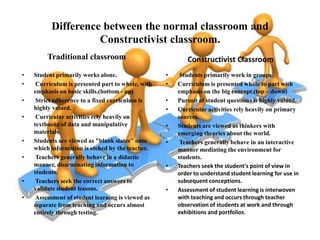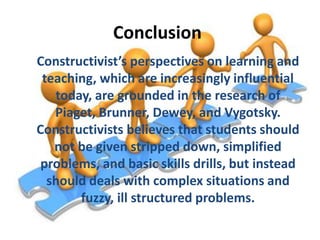Principles of constructivism
- 1. Class PresentationConstructivists Theory of Learning Priti Rai GR598 Zaw Htike GH368 Minisha GK1074 Boishi GS1404
- 2. Introduction • Constructivist theory of learning is grounded in the educational philosophy. Constructivist is the process those structures of knowledge can be stored in memory and retrieved when needed learning is modification but the important of learning happen inside the head of the individual so constructivist perspective challenge such views of learning
- 3. Common definitions of Constructivism. •Constructivism is a philosophy of learning founded on the premise that, by reflecting on our experiences, we construct our own understanding of the world we live in. Click on the following links to help explain constructivism and learn about several guiding principles of constructivism and how it impacts our learning. •Constructivism is a theory of learning based on the idea that knowledge is constructed by the knower based on mental activity. Learners are considered to be active organisms seeking meaning. but will become increasing more complex, differentiated and realistic as time goes on. •Constructivism is a theory of knowledge that argues that humans generate knowledge and meaning from an interaction between their experiences and their ideas. During infancy, it is an interaction between their experiences and their reflexes or behavior-patterns •Constructivist theory of learning is grounded in the educational philosophy. Constructivist is the process those structures of knowledge can be stored in memory and retrieved when needed learning is modification but the important of learning happen inside the head of the individual so constructivist perspective challenge such views of learning
- 4. Types of Constructivism: • Rational constructivism • Radical constructivism • Dialectical constructivism
- 5. Principles of Constructivism •It takes time to learn. •Learning is an active process in which the learner uses sensory input and constructs meaning out of it. •People learn to learn as they learn. •The crucial action of constructing meaning is mental
- 6. • • • • • Learning is a social activity Learning involves language. Learning is contextual. One needs knowledge to learn. Learning is not the passive acceptance of knowledge which exists "out there“. • Motivation is a key component in learning.
- 7. Proponents of Constructivism • John Dewey (October 20, 1859 – June 1, 1952) • Lev Vygotsky (Lev Semyonovich Vygotsky) November 17, 1896 – June 11, 1934) was a Soviet psychologist and the founder of cultural-historical psychology. • Jerome Seymour Bruner (born October 1, 1915) • Jean Piaget (9 August 1896 – 16 September 1980)
- 8. How to apply in the classroom?
- 9. Encourage and support student initiative and autonomy.
- 10. Try to use raw data and primary sources, in addition to manipulative, interactive, and physical materials.
- 11. Create a thinking and problemsolving environment.
- 12. Use coaching and supporting to build student understanding.
- 13. Frame tasks using processes such as classifying, analyzing, predicting and creating.
- 14. Encourage communication between the teacher and the students and also between the students.
- 15. Encourage student critical thinking and inquiry by asking them thoughtful, open-ended questions, and encourage them to ask questions to each other.
- 16. Provide enough time for students to construct their own meaning when learning something new.
- 17. • • • • • • • Lecture = 5% Reading = 10% Audiovisual = 20% Demonstration = 30% Discussion Group = 50% Practice by doing = 75% Teach others / immediate use of learning = 90%
- 18. Difference between the normal classroom and Constructivist classroom. Traditional classroom • • • • • • • • Student primarily works alone. Curriculum is presented part to whole, with emphasis on basic skills.(bottom - up) Strict adherence to a fixed curriculum is highly valued. Curricular activities rely heavily on textbooks of data and manipulative materials. Students are viewed as "blank slates" onto which information is etched by the teacher. Teachers generally behave in a didactic manner, disseminating information to students. Teachers seek the correct answers to validate student lessons. Assessment of student learning is viewed as separate from teaching and occurs almost entirely through testing. Constructivist Classroom • • • • • • • • Students primarily work in groups. Curriculum is presented whole to part with emphasis on the big concept.(top – down) Pursuit of student questions is highly valued. Curricular activities rely heavily on primary sources. Students are viewed as thinkers with emerging theories about the world. Teachers generally behave in an interactive manner mediating the environment for students. Teachers seek the student's point of view in order to understand student learning for use in subsequent conceptions. Assessment of student learning is interwoven with teaching and occurs through teacher observation of students at work and through exhibitions and portfolios.
- 19. Conclusion Constructivist’s perspectives on learning and teaching, which are increasingly influential today, are grounded in the research of Piaget, Brunner, Dewey, and Vygotsky. Constructivists believes that students should not be given stripped down, simplified problems, and basic skills drills, but instead should deals with complex situations and fuzzy, ill structured problems.

